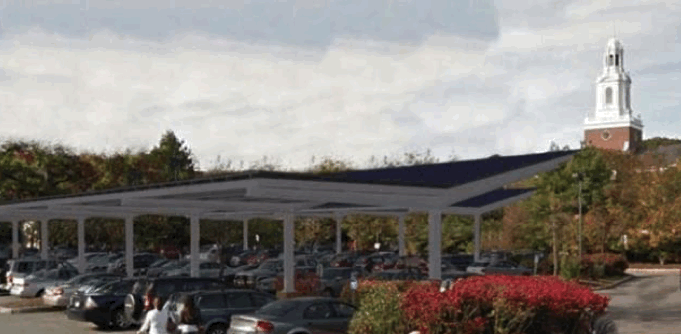The Newton Solar Phase 3 Proposal would require moving or replacing 28 trees—a little more than 0.1% of our street trees—to generate 4.3 million kWh per year, increasing the solar share of our municipal electricity from 21% to 41%. How does that compare to other options?
Improve energy efficiency. Great choice. But it will take heroic efficiency and conservation efforts just to hold electricity use close to today’s levels, especially as we increase electrifying vehicles, heating systems, and industrial processes, using clean electricity to replace fossil fuels.
Solar rooftops. Great choice. But a detailed study by an MIT team for the city of Cambridge found that using all suitable rooftops could only supply 5-25% of total electricity use. Cities use LOTS of electricity.
Solar farms. Good choice. In theory, we could meet the country’s entire electricity use from solar farms on only 0.4% of our land area. But that still means a solar farm equal to the Solar phase 3 proposal would require clearing 14 acres, killing and/or preventing growth of almost 3,000 trees.
Wind farms. Good choice. But New England wind farms require clearing trees from ridgelines, roads to haul equipment to the ridgeline, and transmission connections to the grid. To equal Solar phase 3, it would mean clearing 1.5 acres and losing 300 trees. Plus putting new high voltage power lines through our forests.
Offshore wind. Great choice. We may still have to lose trees to strengthen the transmission system, and have to scrape up the ocean floor for foundations and cables, and drive away sea mammals for years with construction noise. Some birds will be killed. Fishing fleets worry about harming fishing grounds. Most importantly, we can’t have a reliable and resilient electric system using only one source.
Canadian hydro. Meh, but maybe still necessary to decarbonize our electricity. A reservoir to equal the output of Solar 3 would require 35 acres, about 7,000 trees. And new roads, and hundreds of miles of new transmission lines through Canadian & Maine woods.
Natural gas. Please read the Ken Ward article, “Powerless: What it looks and sounds like when a gas driller overruns your land,” ProPublica, December 20, 2018. Or “How gas demand from Boston changed a faraway island,” Boston Globe, December 30, 2018 [ignoring its contention that more pipelines are needed or would be better.] Then think about treeless pipeline corridors, compressor stations, explosions, and gas leaks killing our street trees. And climate change.
There’s no way we can meet our energy needs without harming some trees.
Below are some responses to the Newton Villages Association alert:
- “We need clean energy but we need oxygen even more.” The oxygen deficit from moving or replacing 0.1% of our street trees, plus yard and park trees?
- “Urban trees are critical for sequestering carbon.” Solar phase 3 will reduce carbon by the equivalent of planting 2,340 acres of trees!
- “Heat island effect.” Solar canopies reduce it, maybe more than immature trees.
It may be reasonable to argue that open space and urban trees provide more benefits and are more precious than the equivalent open space and trees in remote areas. I have personally spoken to rooms full of wind energy opponents in Western Massachusetts and Cape Cod. After all the technical questions are answered, after all the myths have been addressed, there is always one question that still wins applause among the opponents: “Why should we have our ridgelines/ocean views/woods spoiled just so that you city people can get all the energy you want?”
If we in Newton cannot accept the sight of solar panels over our parking lots, if we cannot accept having to move or replace 28 trees to be able to increase solar to 41 percent of our municipal energy use, how would you answer that question?
For more details, & links to sources, email alannogee@yahoo.com.
The above post was originally published on the website village14.com by by Nogee is the founder of Friends of Cold Spring Park and former clean energy program director of Union of Concerned Scientists. (Organizational affiliations for identification purposes only.) See the original post HERE.


Recently on Twitter